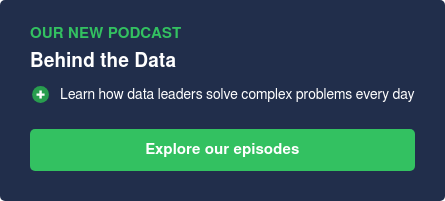An operational data store (ODS) houses and processes transactional data in real-time. They collate current data from various source systems to provide a snapshot of your business at one point in time. You can use the data inside for day-to-day data processing tasks, such as reporting and analysis.
Often, organizations design these stores with a specific business function in mind. Teams can then use the data for tactical business decision-making purposes. If there’s an immediate problem within a business function, an ODS may hold the key to a fast resolution.
But how exactly do these stores work?
In this overview, we’ll dissect what they are and how they can benefit your business.
How do they work?
Operation data stores extract, store, and transform information from your various data sources into a standardized format. The store presents the data for use in business intelligence or analysis platforms.
As the database integrates data, information automatically overwrites whenever there’s up-to-date information. That means there are no historical records of past data.
While it may sound very similar to a data warehouse, there are some key differences.
Operational data store vs data warehouse: What’s the difference?
An operational data store sits in between your data sources and enterprise data warehouse. Consider it the middle ground between the operational side of your business and your business intelligence. It continually collects current, real-time operational data into one central place, ready for smaller-scale, day-to-day queries and analysis.
Data vaults, warehouses, lakes and hubs explainedData warehouses, on the other hand, are much bigger beasts. They perform queries on larger sets of data, which is a much more complex and highly structured task. What’s more, data warehouses record historical and cross-functional data, making them more appropriate for longer-term enterprise analysis, decision-making, and auditing.
You can feed your ODS data into an enterprise data warehouse, but not vice versa.
5 benefits of an ODS
What makes an operational data store useful for businesses such as yours?
Here are five compelling advantages.
1. Up-to-date operational data
As an operational data store collects only current data, functions across your business can use it as a way to get real-time information fast. This is particularly helpful if you need to identify and remedy immediate operational issues. It’s also useful for accessing rapidly changing data to answer pressing questions, which is hard to do in a slower-moving data warehouse.
2. Data halfway house
Many organizations house data in these stores before moving it to a bigger enterprise warehouse. This intermediary step configures the data into one consistent format, which can improve the overall data quality as it enters your data warehouse.
3. Consolidated source data
Rather than looking for answers in disparate source systems, an operational data store extracts real-time data from new and existing systems. This simplifies the reporting process and ensures you’re gathering operational data in one central depository.
Of course, this saves time that you may have once spent searching for data.
4. Reduced performance issues
An ODS essential acts as a ‘staging area’. As you’re not trying to perform data analysis on your business’s actual operational systems, you lighten some of the load. This means it’s less likely you’ll face issues with your operational systems.
5. Cost-effective to implement
In comparison to data warehouses and data lakes, operational data stores are much cheaper to build and implement.
What are the top disadvantages of operational data stores?
There can be some downsides to operational data stores too, including:
1. Management and complexity
The more data you store in an ODS, the more difficult management will be. This is because larger volumes of data will alter the performance of the entire system. Not to mention the maintenance costs.
Therefore, you need to carefully consider what data you want in your store. (And what data isn’t necessary.)
2. Orchestrating the integration
Integrating data from a number of different sources, some of which may be on-premises or in the cloud, is a challenge. You’ll need to ensure all the data matches in order to maintain a single source of the truth. Otherwise, you’ll have a complicated mess of data that doesn’t quite line up.
3. Data transformation
In order to improve the quality of your data and organize it into a consistent format, you’ll need to transform it.
Of course, ODS systems work fast. If your business functions want a piece of data quickly for operational analysis, you’ll need to transform it very quickly. If you don’t have an ETL tool to hand, this can be a demanding task.
4. Analysis and audits
We’ve already said it a number of times, but an ODS focuses on current data. As it doesn’t store historical data, you cannot use it for deeper operational analysis or data auditing.
For that, you’ll need to dive into your enterprise data warehouse.
Should you use an ODS?
Did you know that over half of businesses lose out on opportunities because they didn’t have the right information at the time they needed it?
Accessing data, on time, can increase business performance by up to 21%. This is what makes operational data stores a compelling opportunity.
As the information stored within them is current, it helps your business functions to access current transactional data fast. (Rather than search for it in disparate source systems.) It can also aid with data quality and source data consolidation.
That said, like with any data system, an ODS can become rather complex (and costly) the more data it houses. So, your organization will need to consider its use case carefully.
If you’d like to learn more about all things data architecture, take a look at our Guide to Enterprise Data Architecture.
.jpg)




847d.jpg?width=800&height=450&name=luke-van-zyl-koH7IVuwRLw-unsplash%20%281%29.jpg)